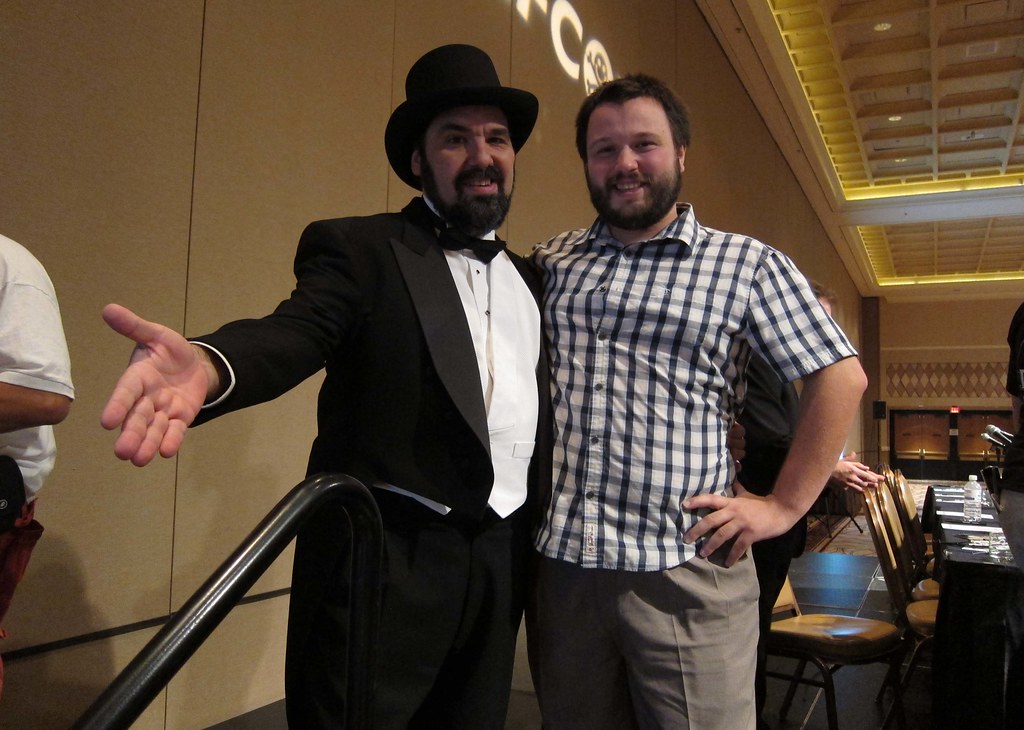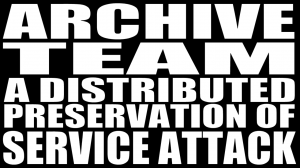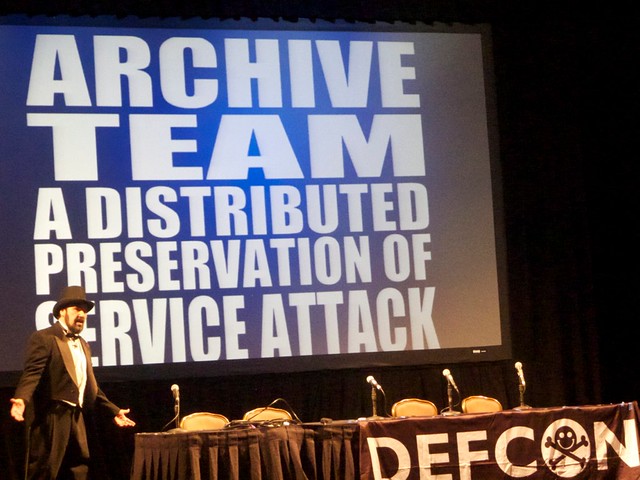Archive Team Talk Post-Mortem —
There’s enough going on both behind the scenes and onstage with the Archive Team talk at DEFCON, I think it functions on multiple levels as an explanation of speaking techniques, how I design presentations, and what the approach was for it. You really should have watched the speech before reading this entry – here’s the entry on this weblog about seeing the video. I’ll assume you have, and move on.
General Hardware/Software/Stage
The hardware was an HP laptop that’s pretty much on the outs, but can handle flipping through images well enough. (I’ve had it for 4 years or something.) The tux was rented in Las Vegas from Tuxedo Junction, a firm just off the strip that will suit you up in under half an hour, and will often just send you out with your outfit (and top hat, which I also rented), and even has a service where they’ll send someone to pick the tux up from your hotel concierge. A tuxedo just brightens up the whole room – check out me and Schuyler Towne:

I mostly wanted to have formal wear for my presentation because I’d asked for, and gotten, the Penn and Teller Theater, which I imagined would be a fantastic venue and was not disappointed. The video doesn’t have establishing shots or anything, but it just looks and feels fantastic in there, as great as many Broadway theaters I’ve been in as a patron, so being on stage was just stellar.
I use OpenOffice Impress for my presentation software. I’ve switched to LibreOffice on my new laptops, but it’s essentially the same thing. It has everything I need, and I can work with it really quickly. It used to crash a lot, but now it rarely crashes, and I’ve never had a crash during a presentation.
DEFCON handled the recording, the sound setup, the video setup. I wore a lav mic that had a wire coming from it (the organizers of DEFCON have apparently sworn off wireless microphones in this environment), and there was also a microphone on the podium, which picked me up occasionally. I thought it all went off smoothly.
All my favorite speeches have me standing next to a massive screen that dwarfs me, and this was a good example of that – I could stand near it and point to things or just dance next to the image, and you got to see both in action. Here’s a shot of that:
If I had to come up with anything I didn’t like of how the speech went off, it’s that I drink a lot of water – maybe it was the combination of the Las Vegas heat and wearing such an elaborate outfit, but I had to keep drinking water, which took up one of my hands. But I can live with this.
Content/Arc
Okay, I do not recommend this for most speakers, and it’s not the way that should work for most people, but if it’s not obvious from the video, I have absolutely no speaking notes. No cue cards, no prompter, no notepad with words, nothing. Everything is being said from memory, or made up on the spot, or being prompted by the slides.
There’s two talks I do, primarily: One where I am acquainted with the subject, and one where I am aware of the subject. The first talks are much more fact filled – the second talks are much more ranty, riffy, and sometimes are lost completely in a flood of interconnected but ultimately non-cohesive thoughts. I try and give the first one whenever possible.
In some cases, I know the subject so well, am pulling directly from memory, that I can construct what I am saying on the spot from memory, and I think this contributes to a much more flowing and organic speech, one that feels like you’re being conversationally told a story. Obviously, this is not for everyone – if your talk is about this new exploit or the construction of an item, you want all the little points in a row and to bring them to the audience exactly. My talks are about ideas and people, so that’s not so important.
Improvisation is a big part of what I do. Some of my bigger laugh lines in there are made up on the spot. “I have plans for your car”, “Getting fucked for shipping costs”, “Probably not going to be flown to America”, “Bulgy McFishHat” … I heard these the same time the audience did. “Food Museum”, “Yahoo! is a clown car”, “Keep Backups”… those were thought of beforehand. So there’s no rhyme or reason to it.
I pay a lot of attention to the audience reaction, probably more than is reasonable. I’m fast thinking with regards to moving the speech in general directions, zipping to the next idea, slowing down to regard an item or concept for the sake of the group. Obviously I can do nothing for the majority of people who will be watching this on a recording, but feeling things out with the audience works for me.
So the outline, which came from the slides, is basically:
- Introduction
- Dedication to Tim Recher
- Soy Sauce Story
- The Importance of Physical Artifacts
- The Importance, therefore, of Digital Artifacts
- Everybody is shutting down
- Archive Team is Formed
- Geocities Project
- Why Geocities has Meaning
- Yahoo! Sucks
- Various Site Saves: Friendster, Lulu Poetry, Google Video
- Outside Projects: OLDUSE.NET, TELEHACK.COM
- Inside Projects: Wikiteam, URL Team, Away from Keyboard
- Conclusion
Throughout this talk, if I find I’m going fast or I’m getting behind (and I use an internal clock, mostly dating back to my film/mass media degree and pro experience), I will add little sidepaths, like how I go off on Google Video for a while, or skip over the “Jason Meme” thing because I want to get to some more good stuff.
What I intentionally did was flip between highly emotional, highly intense stories and moments of hilarity and lightness, tripping along giving the finger as I go. I don’t think it’s good to make the speech into a maudlin tale of lost history, but an endless drunk-sounding riff on Keeping Shit Around wouldn’t impart the seriousness ever. So I swapped between them.
Timing myself, the Soy Sauce story goes for the first five minutes. That’s quite a risk – but in this case it paid off.
And yes, that is really some of Tim Recher’s ashes I hold up at the end. I figured that was the first time someone’s had human ashes at a DEFCON talk, and he was getting spread around the strip by his family anyway – so why not spend some time on stage first?
Presentation Style
I really, really wanted to be out on stage, and not behind a podium. Note how this makes me a pacing weirdo as I go over to hit the arrow key to do slides, but this pause also gives me time to think, which you might see if you watch me carefully. Notice how I make extra effort to use my hands, to use my body, to smile or frown. I am not afraid to turn away from the audience or turn to the screen, because I am mic’d very well. I turn to the screen for moments of incredulity. I turn to the audience for moments of anger. The sense, I hope, is of someone very passionate about their subject, very knowledgeable of what they speak, who is sharing something meaningful to them, not just a boring pitch.
I can ratchet profanity up and down as needed – I wanted this talk to show the rough and tumble way Archive Team operates and the extreme approach I can take as a participant. It means that everyone linking to the video has to add a profanity warning, or just hope for the best. I could have given this talk with no profanity, but I liked peppering it in for a DEFCON speech, because DEFCON has to walk this fine line of being a hacking convention and being a respectable dissemination of information. I wanted to keep the spice in. It’s not for everyone; I do get complaints. Fuck those guys.
I don’t get nervous in front of crowds. I am facing something like 1,000 people here, and there’s just no effect on me – it might as well be 2. I don’t know why this is the case, but obviously I make the most of it to be able to focus on other aspects of the presentation other than fear of crowds.
For talks like this, I never respond to the audience shouting out – I will not slow the train to pick up one passenger. That’s a personal choice – if the talk required more collaboration that moment, I might be inclined to respond, but not here.
Conclusion and Future
My hope is that this talk, along with other ones I’ve given, could hold up as resume pieces for doing more public speaking. I’ve got some keynotes and presentations in the works for the next year, depending on the choice of committees and stuff out of my hands, and people advocating for me can point to this video and others and say “This is what he’s like.” And it stands as an accurate portrayal. I can’t be something I’m not, and I’m very, very happy with how things come across on this one.
So there you go. I’ll answer further questions as they come.
Keep speaking!
Categorised as: Archive Team | jason his own self | Speaking
Comments are disabled on this post


“the organizers of DEFCON have apparently sworn off wireless microphones”
I wonder why that was… 😉
Great tips thanks Jason. This is one of the better digital preservation talks i have ever seen (live or recorded in this case). Your post here demonstrates that a lot of work goes into a successful talk. The soy sauce story and “backups are important” line was inspired. I thought for sure though the Ebay “getting fucked on shipping” was also a prepared line. That was hilarious, popped into my head a day later for a re-chuckle. Keep up the good work. Hope our paths cross professionally one day.
glad to see you out of those crazy bowling shirts for once. 😀